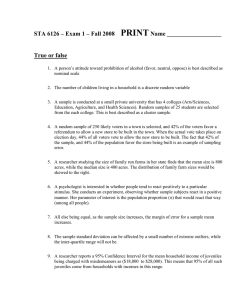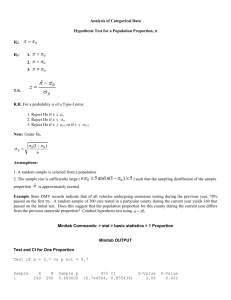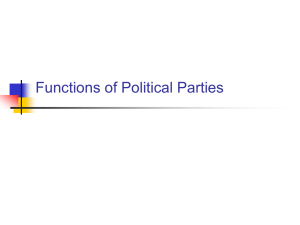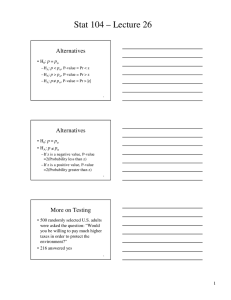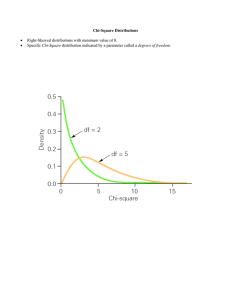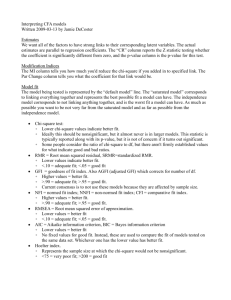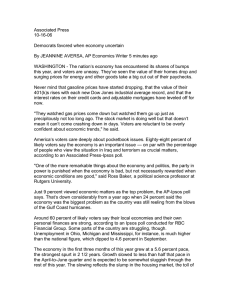Minitab Demonstration for Chi-Square Goodness of Fit Test and Chi-Square Test of Independence.doc
advertisement
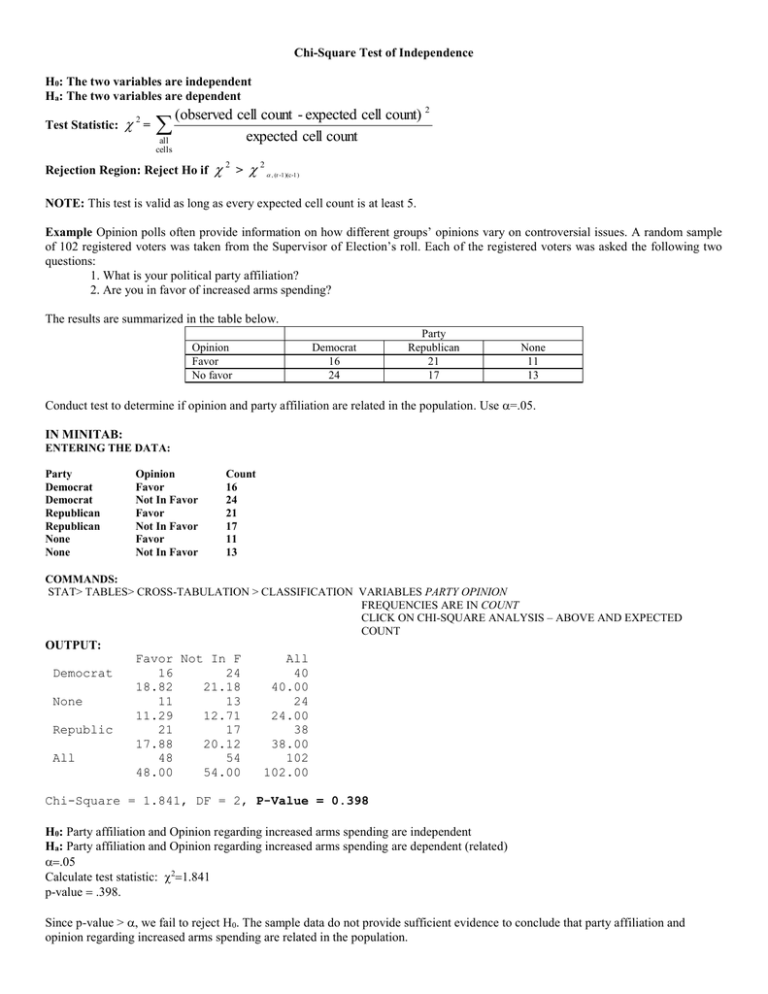
Chi-Square Test of Independence H0: The two variables are independent Ha: The two variables are dependent Test Statistic: 2= (observed cell count - expected cell count) 2 expected cell count all cells Rejection Region: Reject Ho if 2 > 2 , (r -1 )(c -1 ) NOTE: This test is valid as long as every expected cell count is at least 5. Example Opinion polls often provide information on how different groups’ opinions vary on controversial issues. A random sample of 102 registered voters was taken from the Supervisor of Election’s roll. Each of the registered voters was asked the following two questions: 1. What is your political party affiliation? 2. Are you in favor of increased arms spending? The results are summarized in the table below. Opinion Favor No favor Democrat 16 24 Party Republican 21 17 None 11 13 Conduct test to determine if opinion and party affiliation are related in the population. Use =.05. IN MINITAB: ENTERING THE DATA: Party Democrat Democrat Republican Republican None None Opinion Favor Not In Favor Favor Not In Favor Favor Not In Favor Count 16 24 21 17 11 13 COMMANDS: STAT> TABLES> CROSS-TABULATION > CLASSIFICATION VARIABLES PARTY OPINION FREQUENCIES ARE IN COUNT CLICK ON CHI-SQUARE ANALYSIS – ABOVE AND EXPECTED COUNT OUTPUT: Democrat None Republic All Favor Not In F 16 24 18.82 21.18 11 13 11.29 12.71 21 17 17.88 20.12 48 54 48.00 54.00 All 40 40.00 24 24.00 38 38.00 102 102.00 Chi-Square = 1.841, DF = 2, P-Value = 0.398 H0: Party affiliation and Opinion regarding increased arms spending are independent Ha: Party affiliation and Opinion regarding increased arms spending are dependent (related) Calculate test statistic: p-value Since p-value > , we fail to reject H0. The sample data do not provide sufficient evidence to conclude that party affiliation and opinion regarding increased arms spending are related in the population. Chi-Square Goodness-of-Fit Test H0: 1 = hypothesized population proportion for category 1 . . . k = hypothesized population proportion for category k Ha: H0 is not true, so at least one of the category proportions differs from the corresponding hypothesized value. Test Statistic: 2= (observed cell count - expected cell count) 2 expected cell count Rejection Region: Reject H0 if 2 > 2 , k -1 NOTE: This test is valid as long as every expected cell count is at least 5. Example In previous presidential elections in a given locality, 50% of the registered voters were Republicans, 40% were Democrats, and 10% were registered as independents. Prior to the upcoming election, a random sample of 200 registered voters showed that 90 were registered as Republicans, 80 as Democrats, and 30 as independents. Is there sufficient evidence to conclude that the distribution of registered voters is different from that in previous election years. Use =.01. In Minitab Spreadsheet: C1 90 80 30 C2 0.5 0.4 0.1 COMMANDS: STAT> TABLES> Chi-Square Goodness-of-Fit Test > Observed counts C1 > specific proportions C2 Chi-Square Goodness-of-Fit Test for Observed Counts in Variable: C1 Category 1 2 3 N 200 DF 2 Observed 90 80 30 Chi-Sq 6 Test Proportion 0.5 0.4 0.1 Expected 100 80 20 Contribution to Chi-Sq 1 0 5 P-Value 0.050 R = the proportion of all of this year’s registered voters that are Republicans D = the proportion of all of this year’s registered voters that are Democrats I = the proportion of all of this year’s registered voters that are Independents H0: R = .5 D = .4 I = .1 Ha: H0 is not true, so at least one of the category proportions differs from the corresponding hypothesized value. =.01 Calculate test statistic: p-value Since p-value > , we fail to reject H0. The sample data do not provide sufficient evidence to conclude that the distribution of registered voters in the given locality is different from that in previous election years.
